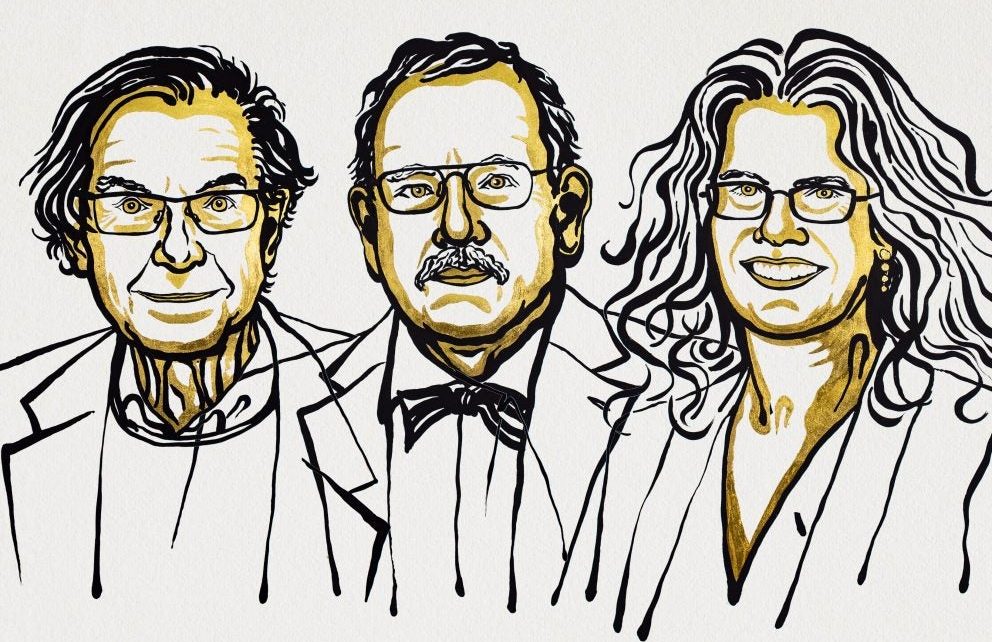This year’s Nobel Prize in Physics was awarded to three scientists for their work on black holes. British cosmologist Roger Penrose will receive half of this year’s prize, with the remaining half split between German astrophysicist Reinhard Genzel and American astrophysicist Andrea Ghez. Ghez is only the fourth woman in history to receive the venerable physics prize.
“This year’s prize is about the darkest secrets of the universe,” said Göran K. Hansson, Secretary General of the Royal Swedish Academy of Sciences. The Academy recognized Penrose, Hansson said, for his “discovery that black hole formation is a robust prediction of the general theory of relativity,” Hansson said, while Ghez and Genzel were awarded “for the discovery of a supermassive compact object at the center of our galaxy.”
Black holes are regions of space in which the force of gravity is so strong that not even light can escape. To create one, noted Ulf Danielsson, a physicist on the Nobel committee, “you’d need to compress the sun into a region only a few kilometers across—or to squeeze the Earth down to the size of a pea.” Although scientists had speculated about their existence for centuries, it was unclear whether such extreme objects could occur in reality.
In 1965 Penrose, now a professor emeritus at the University of Oxford, mathematically “showed that black holes might really exist, forming in a stable and robust process” consistent with Albert Einstein’s theories, said David Haviland, a physicist at the Royal Institute of Technology and chair of the physics prize committee. While Penrose and other theorists were codifying the physical foundations of black holes, observational astronomers were searching for and studying these exotic objects in ever-greater detail.
A breakthrough discovery began to emerge in the 1990s. Genzel—the director of the Max Planck Institute for Extraterrestrial Physics in Garching, Germany—and Ghez, who is a professor at the University of California in Los Angeles, were each helming independent research teams using powerful infrared telescopes to peer into the dust-shrouded heart of the Milky Way. There, both teams witnessed stars swarming around a mysterious central dark source, an unseen object that the stars’ motions suggested must contain the mass of 4 million suns. “There is no other explanation than a supermassive black hole,” Danielsson said.
Subsequent observations, chiefly from the Hubble Space Telescope, have revealed that such scale-tipping black holes lurk in the centers of most every large galaxy in the observable universe, hinting that these objects, far from being mere astrophysical curiosities, are perhaps the universe’s most crucial building blocks for large-scale cosmic structures.
“Science is so important, and presenting the reality of our physical world is critical to us as human beings,” Ghez said in an interview after learning of her award. “We have no idea what’s inside black holes…They really represent the breakdown of our understanding of the laws of physics. That’s part of the intrigue—we still don’t know.”
Genzel’s and Ghez’s teams continue to make new discoveries about the Milky Way’s central supermassive black hole, dubbed Sagittarius A*, such as knots of superheated gas that flare to brilliance as they spiral into oblivion. New facilities such as the Laser Interferometer Gravitational-Wave Observatory (LIGO) and the Virgo Interferometer are studying merging pairs of black holes by their emission of ripples in spacetime called gravitational waves. And ongoing radio observations of Sagittarius A* as well as another supermassive object in the nearby galaxy M87 by the globe-spanning Event Horizon Telescope are generating revolutionary close-up images of these cosmic monsters.
“This is not just an old adventure coming to its triumphant conclusion,” Danielsson said. “It’s a new one beginning. As we probe ever closer to the horizons of the black holes, nature might have new surprises in store.”



